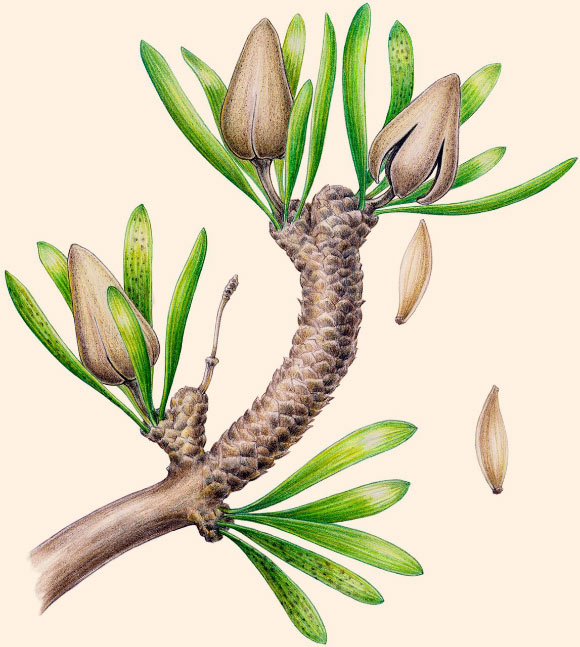Exceptionally well-preserved specimens unearthed in Early Cretaceous sediments of Mongolia belong to an ancient, dinosaur-era relative of the living plant Ginkgo biloba (today is native only to China).

Reconstruction of Umaltolepis mongoliensis showing four seed-bearing structures and attached Pseudotorellia resinosa leaves. Note that three seed-bearing organs have split at the level of the flange into four lobes releasing the seeds. The seeds (right) were probably membranous and wind-dispersed. The cupule has been shed from one of the seed-bearing structures leaving the stalk, flange and column attached to the short shoot. Most, probably all, of the small dark spots on leaves are the remains of fungal stromata. Image credit: Fabiany Herrera et al, doi: 10.1073/pnas.1621409114.
An international team of paleontologists led by Yale researcher Peter Crane discovered the fossils — from the extinct plant Umaltolepis mongoliensis — in ancient peat deposits at the Tevshiin Govi mine in the steppes of central Mongolia.
“The stems and leaves are similar to the ginkgo tree, but the seeds, and especially the structures they are born in, are unlike any other known plant, living or extinct. Finding something like this does not happen very often,” said team member Dr. Patrick Herendeen, from the Chicago Botanic Garden.
Paleontologists had previously uncovered fossils of Umaltolepis, but those were in poor condition, making them difficult to study.
Hundreds of better-preserved new specimens show that features of the stems and leaves are similar to those of Ginkgo biloba.
“However, the seed-bearing structures are not like those of today’s ginkgo tree,” Dr. Herendeen said.
“Ginkgo has large seeds with a fleshy outer covering, but Umaltolepis mongoliensis has small, winged seeds.”
“As they developed, Umaltolepis mongoliensis seeds were protected inside a tough, resinous, umbrella-like outer covering, which stayed almost completely closed, opening only to release the seeds.”
The key to determining how Umaltolepis mongoliensis is related to other seed plants lies in understanding its strange seed-bearing capsules.
While the Umaltolepis mongoliensis seeds are dissimilar to those of any other living or extinct plant, preliminary comparisons connect them with the seed-bearing structures of two groups of extinct plants that may be part of the ginkgo lineage.
These comparisons and the unique features of Umaltolepis mongoliensis indicate that ginkgo is the last living member of a group of plants that was much more diverse and important in the past.
“Umaltolepis mongoliensis provides new data for understanding relationships among living and fossil seed plants and supports previous ideas that Ginkgo biloba may be the sole surviving relict of a once very diverse group of Mesozoic seed plants,” the researchers said.
Research describing Umaltolepis mongoliensis is published online in the Proceedings of the National Academy of Sciences.
_____
Fabiany Herrera et al. The presumed ginkgophyte Umaltolepis has seed-bearing structures resembling those of Peltaspermales and Umkomasiales. PNAS 114 (12): E2385-E2391; doi: 10.1073/pnas.1621409114







